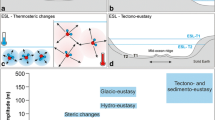Abstract
Using an interdisciplinary three-dimensional physical and biogeochemical model developed for the Black Sea, the long-term evolution of marine dynamics and ecosystem is investigated. The hydrophysical fields were calculated from a model of Black Sea circulation with assimilation of hydrographic survey and satellite measurement data from 1971 to 2001. The circulation model reproduces well processes of various scales in both space and time (particularly the seasonal course and interannual variability of main hydrophysical fields). The resulting flow fields are then used to calculate the long-term evolution of the components of the lower level of the food chain in the Black Sea ecosystem. The biogeochemical model used in the calculations is based on the nitrogen cycle and includes a parameterization of the main biological and chemical interactions and processes in the upper layer of the Black Sea. The numerical experiments indicated that the biogeochemical component of the model rather successfully reproduces the main features and evolution trends in the Black Sea ecosystem for the period under consideration: the growth in the phytoplankton biomass during eutrophication and changes in seasonal cycles of the main ecosystem components. Also, the hydrophysical processes were shown to be important for a reliable reproduction of long-term changes in the ecosystem.
Similar content being viewed by others
References
S. K. Konovalov and J. W. Murray, “Variations in the chemistry of the Black Sea on a time scale of decades (1960–1995),” J. Mar. Syst. 31, 217–243 (2001).
V. V. Knysh, G. K. Korotaev, V. A. Moiseenko, A. I. Kubryakov, V. N. Belokopytov, and N. V. Inyushina, “Seasonal and interannual variability of Black Sea hydrophysical fields reconstructed from 1971–1993 reanalysis data,” Izv., Atmos. Ocean. Phys. 47(3), 399–411 (2011).
V. V. Knysh, A. I. Kubryakov, N. V. Inyushina, G. K. Korotaev, and V. A. Moiseenko, “Reconstruction of the climatic seasonal circulation of Black Sea using a σ-coordinate model with assimilated temperature and salinity data,” in Ecological Safety of Coastal and Shelf Areas and Integrated Use of Shelf Resouces (MGI NAS of Ukraine, Sevastopol, 2008), Vol. 16, pp. 243–265 [in Russian].
T. Oguz, H. W. Ducklow, and P. Malanotte-Rizzoli, “Modeling distinct vertical biochemical structure of the Black Sea: Dynamical coupling of the oxic, suboxic, and anoxic layers,” Global Biochem. Cycles 14(4), 1331–1352 (2000).
T. Oguz, H. W. Ducklow, J. E. Purcell, and P. Malanotte-Rizzoli, “Modeling the response of top-down control exerted by gelatinous carnivores on the Black Sea pelagic food web,” J. Geophys. Res. 106(C3), 4543–4564 (2001).
T. Oguz, B. Salihoglu, and B. Fach, “A coupled plankton-anchovy population dynamics model assessing nonlinear controls of anchovy and gelatinous biomass in the Black Sea,” Mar. Ecol. Prog. Ser. 369, 229–256 (2008).
C. Lancelot, J. Staneva, D. Van Eeckhout, J. Beckers, E. Stanev, “Modelling the Danube-influenced northwestern continental shelf of the Black Sea. II: Ecosystem response to changes in nutrient delivery by Danube river after its damming in (1972),” Estuarine Coastal Shelf Sci. 54, 473–499 (2002).
M. Grergoire, C. Raick and K. Soetaert, “Numerical modeling of the central Black Sea ecosystem functioning during the eutrophication phase,” Prog. Oceanogr. 76, 286–333 (2008).
M. Grergoire and G. Lacroix, “Exchange processes and nitrogen cycling on the shelf and continental slope of the Black Sea basin,” Global Biogeochem. Cycles 17, 4201–4217 (2003).
M. Grergoire and Friedrich, J., “Nitrogen budget of the north-western Black Sea shelf as inferred from modeling studies and in-situ benthic measurements,” Mar. Ecol. Prog. Ser. 270, 15–39 (2004).
M. Grergoire, N. Nezlin, A. Kostianoy, and K. Soetaert, “Modeling the nitrogen cycling and plankton productivity in an enclosed environment (the Black Sea) using a three-dimensional coupled Hydrodynamicalecosystem model. J. Geophys. Res. 109, C05007 (2004).
T. Oguz, V. L. Dorofeev, and G. K. Korotaev, “Modeling of the Black Sea ecosystem,” Morsk. Gidrofiz. Zh., No. 1, 59–72 (2007).
V. L. Dorofeev, “Modeling the Decadal Variability of the Black Sea ecosystem,” Morsk. Gidrofiz. Zh., No. 6, 49–61 (2009).
W. Ludwig, “Water and nutrient fluxes from major Mediterranean and Black Sea rivers: Past and future trends and their implications for the basin-scale budgets,” Global Biogeochem. Cycles 24, 1–14 (2010).
V. N. Eremeev and S. K. Konovalov, “On the budget formation and regularities in the distribution of oxygen and hydrogen sulfide in the Black Sea,” Morsk. Ekol. Zh. 5(3), 5–29 (2006).
V. V. Knysh, G. K. Korotaev, V. A. Moiseenko, et al., “Seasonal and interannual variability of Black Sea hydrophysical fields reconstructed from 1971–1993 reanalysis data,” Izv., Atmos. Ocean. Phys. 47(3) 399–411 (2011).
V. L. Dorofeev and G. K. Korotaev, “Assimilation of satellite altimetry data into the eddy-resolving model of the Black Sea circulation,” Morsk. Gidrofiz. Zh., No. 1, 52–68 (2004).
J. E. Purcell, T. A. Shiganova, M. B. Decker, et al., “The ctenophore mnemiopsis in native and exotic habitats: U.S. estuaries versus the Black Sea basin,” Hydrobiologia, 451 145–176 (2001).
T. Oguz and D. Gilbert, “Abrupt transitions of the topdown controlled Black Sea pelagic ecosystem during 1960–2000: Evidence for regime-shifts under strong fishery exploitation and nutrient enrichment modulated by climate-induced variations,” Deep-Sea Res. 54(2), 220–242 (2007).
T. Oguz, S. Tugrul, A. E. Kideys, V. Ediger, and N. Kubilay, “Physical and biogeochemical characteristic of the Black sea,” in The Sea, Vol. 14, Ed. by A. R. Robinson and K. H. Brink, (President and Fellows of Harvard College, Harvard, 2004). pp. 1331–1369.
V. V. Suslin, T. Ya. Churilova, and Kh. M. Sosik, “Regional algorithm for the chlorophyll concentration in the Black Sea by SaeWiFS satellite data,” Morsk. Ekol. Zh., No. 2, 24–42 (2008).
Author information
Authors and Affiliations
Corresponding author
Additional information
Original Russian Text © V.L. Dorofeev, G.K. Korotaev, L.I. Sukhikh, 2013, published in Izvestiya AN. Fizika Atmosfery i Okeana, 2013, Vol. 49, No. 6, pp. 676–687.
Rights and permissions
About this article
Cite this article
Dorofeev, V.L., Korotaev, G.K. & Sukhikh, L.I. Study of long-term variations in the Black Sea fields using an interdisciplinary physical and biogeochemical model. Izv. Atmos. Ocean. Phys. 49, 622–631 (2013). https://doi.org/10.1134/S0001433813060054
Received:
Accepted:
Published:
Issue Date:
DOI: https://doi.org/10.1134/S0001433813060054




